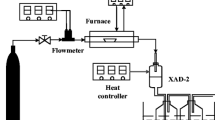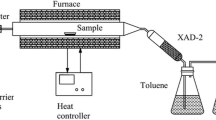Abstract
A large amount of soils are contaminated by leakage of polychlorinated biphenyls (PCBs) from sealed-up PCB-containing electrical equipment in China. Thermal dechlorination of soils contaminated with PCBs at a level of 108 mg g−1 and PCB77 (3,3′,4,4′-tetrachlorobiphenyl) as a model isomer in conjunction with calcium oxide was investigated in this study. The PCB dechlorination rate improved with increased temperature and time. The highest dechlorination rate was 85.3 %, and temperature was the main influencing factor. Pentachlorobiphenyl and tetrachlorobiphenyl in soils decreased or disappeared in response to treatment at 350 and 400 °C for 4 h, while monochlorinated biphenyl and biphenyl were detected after the reaction, indicating the presence of a dechlorination/hydrogenation pathway. Discrepancy in chlorine balance was observed after low-temperature thermal dechlorination. The species of dechlorination products were identified as amorphous carbon containing a crystalline graphite plane structure and a carbonyl group-containing polymerized product, demonstrating the existence of a dechlorination/polymerization pathway. The yield of amorphous carbon and high-molecular-weight intermediates increased with heating time. The results showed that the discrepancy in chlorine balance was because of the generation of polymerized products and undetected intermediates.






Similar content being viewed by others
References
Addink R, Olie K (1995) Mechanisms of formation and destruction of polychlorinated dibenzo-p-dioxins and dibenzofurans in heterogeneous systems. Environ Sci Technol 29:1425–1435
Andrea W, Kei O (2013) The PCBs elimination network: the information exchange platform created for the risk reduction of polychlorinated biphenyls (PCBs). http://chm.pops.int/Implementation/PCBs/PCBsEliminationNetwork/Relatedarticlesandlinks/PCBsInfoexchangeplatform/tabid/3016/Default.aspx
Cudziło S, Huczko A, Pakuła M, Biniak S, Świątkowski A, Szala M (2007) Surface properties of carbons obtained from hexachlorobenzene and hexachloroethane by combustion synthesis. Carbon 45:103–109
Cunliffe AM, Williams PT (2007) Influence of temperature on PCDD/PCDF desorption from waste incineration flyash under nitrogen. Chemosphere 66:1146–1152
Gomes HI, Dias-ferreira C, Ottosen LM, Ribeiro AB (2014) Electrodialytic remediation of PCB contaminated soil with iron nanoparticles and two different surfactants. J Colloid Interface Sci 433:189–195
Huang L, Su G, Zhang A, Shi Y, Xia C, Lu H, Li L, Liu S, Zheng M (2013) Degradation of polychlorinated biphenyls using mesoporous iron-based spinels. J Hazard Mater 261:451–462
Kimbrough RD (1987) Human health effects of polychlorinated biphenyls (PCBs) and polybrominated biphenyls (PBBs). Annu Rev Pharmacool Toxicol 27:87–111
Lee C, Huffman GL (1989) Innovative thermal destruction technologies. Environ Prog 8:190–199
McDowall R, Boyle C, Graham B (2004) Review of emerging: innovative technologies for the destruction and decontamination of POPs and the identification of promising technologies for use in developing countries. http://archive.basel.int/techmatters/review_pop_feb04.pdf
Misaka Y, Abe T, Takeuchi K, Ohba K, Sawabe K, Shobatake K (2006) Dechlorination/hydrogenation and destruction reactions of PCDDs in OCDD-added fly ash heated under vacuum. Chemosphere 65:419–426
Qi Z, Buekens A, Liu J, Chen T, Lu S, Li X, Cen K (2014) Some technical issues in managing PCBs. Environ Sci Pollut Res Int 21:6448–6462
Schoonenboom MH, Olie K (1995) Formation of PCDDs and PCDFs from anthracene and chloroanthracene in a model fly ash system. Environ Sci Technol 29:2005–2009
Stach J, Pekárek V, Grabic R, Lojkásek M, Pacáková V (2000) Dechlorination of polychlorinated biphenyls, dibenzo-p-dioxins and dibenzofurans on fly ash. Chemosphere 41:1881–1887
Subbanna P, Greene H, Desai F (1988) Catalytic oxidation of polychlorinated biphenyls in a monolithic reactor system. Environ Sci Technol 22:557–561
Sun Y, Takaoka M, Takeda N, Wang W, Zeng X, Zhu T (2012) Decomposition of 2,2′,4,4′,5,5′-hexachlorobiphenyl with iron supported on an activated carbon from an ion-exchange resin. Chemosphere 88:895–902
Sun Y, Liu X, Kainuma M, Wang W, Takaoka M, Takeda N (2015) Dechlorination of polychlorinated biphenyls by iron and its oxides. Chemosphere 137:78–86
Tanaka Y, Zhang Q, Saito F, Ikoma T, Tero-Kubota S (2005) Dependence of mechanochemically induced decomposition of mono-chlorobiphenyl on the occurrence of radicals. Chemosphere 60:939–943
The People’s Republic of China (2007) National Implementation Plan for the Stockholm Convention on Persistent Organic Pollutants. http://chm.pops.int/Implementation/NIPs/NIPTransmission/tabid/253/ctl/Download/mid/13657/Default.aspx?id=36&ObjID=6340
Wakayama H, Mizuno J, Fukushima Y, Nagano K, Fukunaga T, Mizutani U (1999) Structural defects in mechanically ground graphite. Carbon 37:947–952
Wania F, Mackay D (1996) Peer reviewed: tracking the distribution of persistent organic pollutants. Environ Sci Technol 30:390–396
Weber R, Nagai K, Nishino J, Shiraishi H, Ishida M, Takasuga T, Konndo K, Hiraoka M (2002) Effects of selected metal oxides on the dechlorination and destruction of PCDD and PCDF. Chemosphere 46:1247–1253
Wiegel J, Wu Q (2000) Microbial reductive dehalogenation of polychlorinated biphenyls. FEMS Microbiol Ecol 32:1–15
Xu Z, Zhao Y, Wang H, Zheng X (2012) Resonance raman spectroscopy and density functional theory investigations on the excited state structural dynamics of n-methylpyrrole-2-carboxaldehyde and its solvent effect. Acta Phys Chim Sin 28:65–72
Yak HK, Lang Q, Wai CM (2000) Relative resistance of positional isomers of polychlorinated biphenyls toward reductive dechlorination by zerovalent iron in subcritical water. Environ Sci Technol 34:2792–2798
Yin K, Gao X, Sun Y, Zheng L, Wang W (2013) Thermal degradation of hexachlorobenzene in the presence of calcium oxide at 340–400°C. Chemosphere 93:1600–1606
Zang WC, Chongyano J (2000) China’s pollution control over POPs and countermeasures. UNEP-Chemicals. Proceedings of the Subregional Workshop on Identification and Management of Dioxins/Furans and PCBs, Seoul, pp 73–76
Zhai Z, Wang Z (2005) Computational study on the relative stability and formation distribution of 76 polychlorinated naphthalene by density functional theory. J Mol Struc Theochem 724:221–227
Zhang W, Huang J, Yu G, Deng S, Zhu W (2010) Mechanochemical destruction of dechlorane plus with calcium oxide. Chemosphere 81:345–350
Acknowledgments
This research was supported by the National Natural Science Foundation of China (21377121).
Author information
Authors and Affiliations
Corresponding author
Additional information
Responsible editor: Hongwen Sun
Rights and permissions
About this article
Cite this article
Gao, X., Ji, B. & Huang, Q. Thermal dechlorination of heavily PCB-contaminated soils from a sealed site of PCB-containing electrical equipment. Environ Sci Pollut Res 23, 15544–15550 (2016). https://doi.org/10.1007/s11356-016-6680-7
Received:
Accepted:
Published:
Issue Date:
DOI: https://doi.org/10.1007/s11356-016-6680-7




